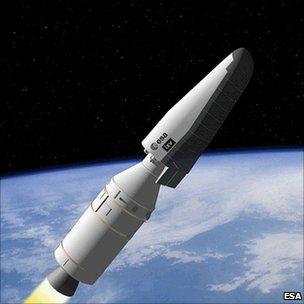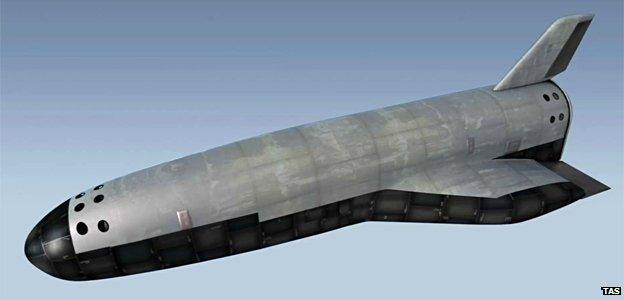Europe's IXV 'space wedge' performs drop test
- Published

The IXV model was recovered from the sea after its splashdown on a parachute
A successful "drop test" has been conducted on Europe's experimental re-entry vehicle, the IXV.
A 1:1 scale model was released from an altitude of 3km by a helicopter, and then descended to a splashdown in the Mediterranean on a parachute.
The IXV is a project of the European Space Agency that aims to develop an autonomous atmospheric re-entry system.
A flight model will be launched on a Vega rocket next year and will have to descend from an altitude of 420km.
The ultimate goal is to develop a vehicle not dissimilar to the American mini spy shuttle called the X-37B, which operates robotically in orbit for a period of time before making an automated return to a runway.
Europe's version will be developed under the name of Pride.
"X-37B is a big vehicle launched on an Atlas rocket, while Pride will be launched on a smaller rocket. It should be a much cheaper mission," explained Roberto Provera from Thales Alenia Space (Tas), the French-Italian company that will lead the project industrially.
"The idea of the two vehicles is very similar, but the size and the costs of the projects are very different," he told reporters here at the Paris Air Show.
IXV (Intermediate eXperimental Vehicle) is the initial step towards Pride. This car-sized, two-tonne spacecraft will launch from French Guiana in South America in August 2014. It will fly an arc reaching 420km above the Earth before coming down to a splashdown zone in the Pacific.

The IXV would be launched atop a Vega rocket
IXV is a lifting body; it has far more manoeuvrability than a standard cone-shaped, re-entry capsule. It has flaps and thrusters to control its descent trajectory. A ceramic heatshield on its underside will prevent the vehicle from burning up.
Its suite of sensors should give European engineers new insights into how objects fall back through the atmosphere and provide them with the data they need to design the next generation of space vehicles.
"We are one year away from launch and Wednesday's drop test at the Salto di Quirra Inter-force Test Range in Sardinia was important to validate this part of the chain," said Mr Provera.
The flight model should be delivered to the European Space Agency (Esa) in May of next year.
Esa member states approved Pride (Programme for Reusable In-orbit Demonstrator in Europe) at their recent ministerial council in Naples, and the agency has just sent Thales Alenia Space a request for quotation (RFQ).
The company will have to detail its initial design thoughts and the likely cost for the project, which has an envelope of about 400m euros.
The Pride vehicle will have to be compatible with the small Vega rocket, also. This means Pride must stay within 5m in length and have a maximum mass no greater than about 1,900kg.
"Pride represents the next step after IXV. You see the shape - it has wings. The mission envisages several orbits, not just an arc over the globe. And it will land on an airstrip," said Mr Provera.
Pride would fly no earlier than 2018.

Pride must be sized to fit on Europe's small launcher, Vega
Jonathan.Amos-INTERNET@bbc.co.uk and follow me on Twitter: @BBCAmos, external
- Published11 December 2012
- Published23 June 2011